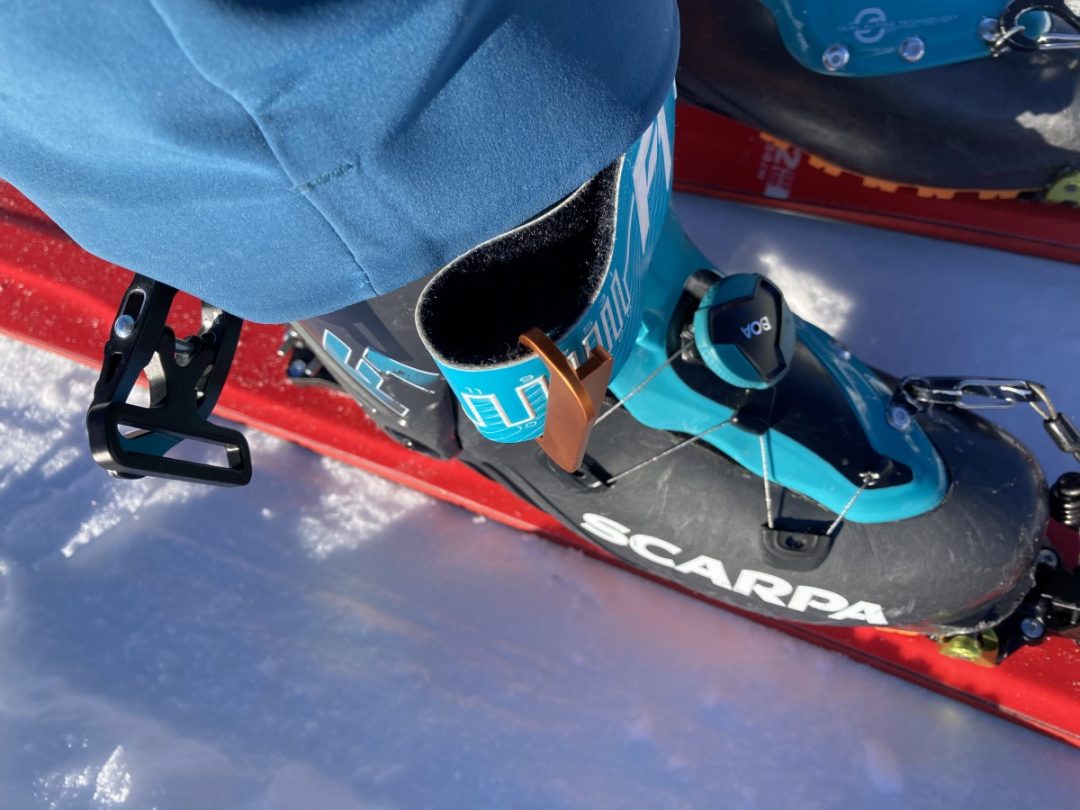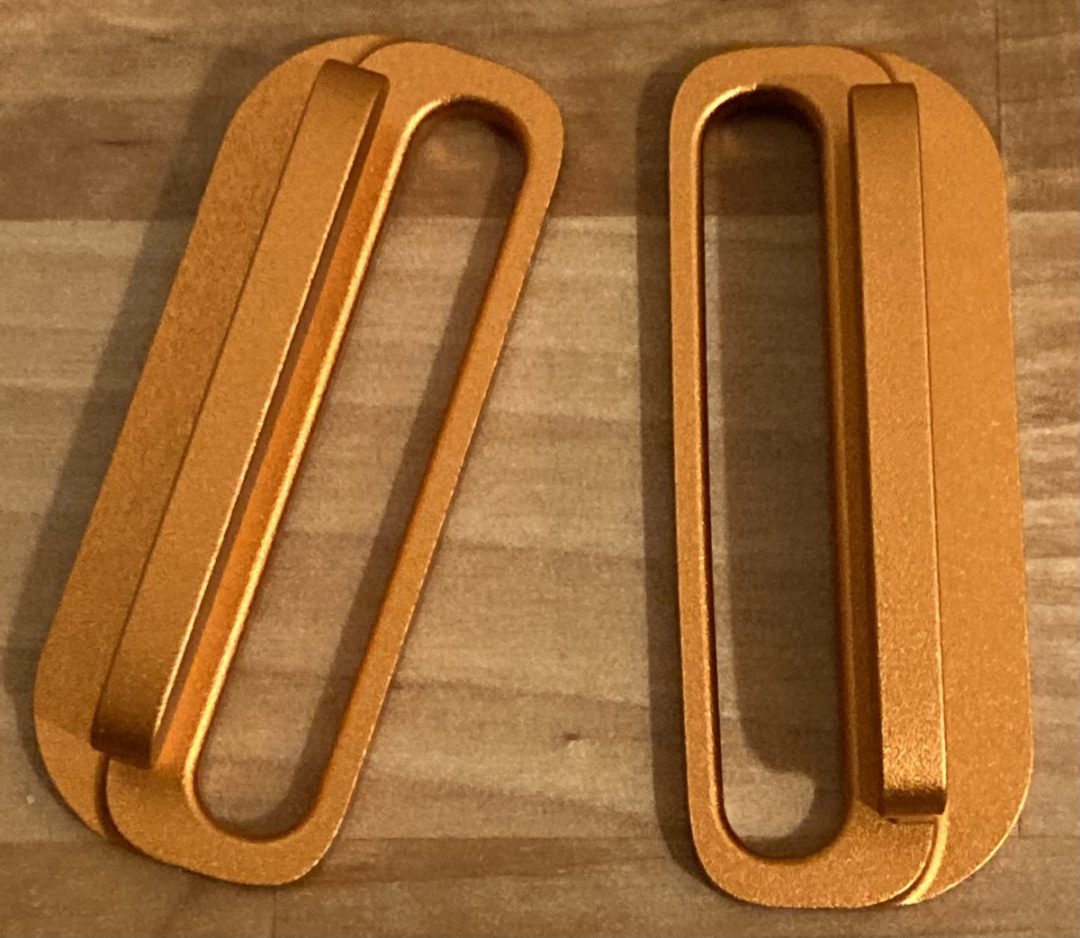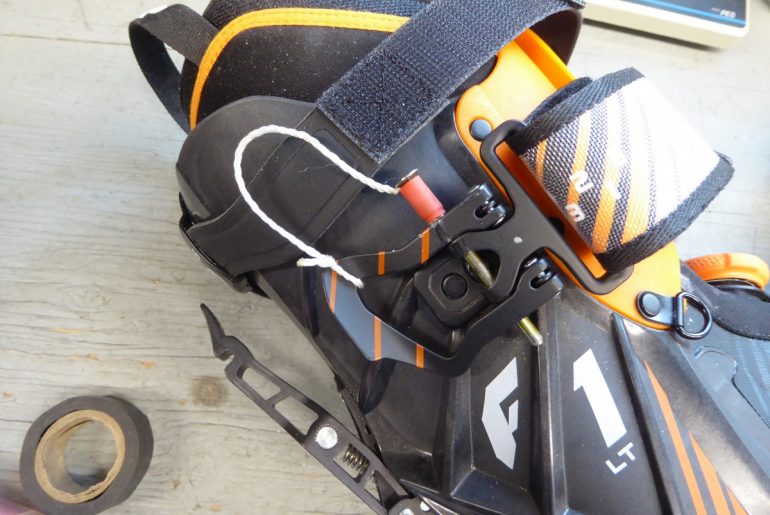
The Strapoff is designed to make easier use of the Scarpa F1 and F1 LT power strap and provide greater range of motion when disengaged.
Author’s note: when asked to review a product called “the Strapoff,” the gods of the satirical universe smile on you, knowing that you can’t not go there. Anything less would be poetically disingenuous. But, I’m not going there, other than this author’s note.
The Strapoff, manufactured by Tahoe Trail Tools, is an 8g CNC machined 6061 aluminum buckle insert, finished in a handsome orange anodized “bling.” As an aftermarket piece you can add the Strapoff to a Scarpa F1 or F1LT 45mm velcro shin strap to facilitate a quick release buckle allowing for maximized forward range of motion. Once the Strapoff is in place, in theory, one no longer needs to adjust the 45mm velcro for either increased range of motion when skiing or cuff-tightening when descending.

The CNC machined Strapoff is an 8g CNC machined 6061 aluminum buckle insert, finished in a handsome orange anodized “bling.” It will set you back $35.00.
Long-time listeners might also recall the 2020 classic “SCARPA F1 LT LOOK AND FITTING — LOU’S TAKE,” where Lou reviews, and mods, the ever-living bejesus out of a pair of F1 LTs. In the article, Lou begs for a legit solution to solve his velcro strap fight. Lou’s, personally much enamored, but lacking in marketing charm, solution was a 16d nail electrical taped (red for style points) to a hank of cotton string, tied off to the stock buckle. A photo caption from that post illuminates what Lou found so disdainful, and what the Strap On tries to solve. Lou wrote, “One thing I intensely dislike about this sort of boot design is the need to adjust the hook-loop buckle strap every time the boots go off, and back on. What’s needed is a way to unhook the buckle while leaving the strap adjusted. 16d nail to the rescue.”

From Lou’s original post: “I was on the mod-trail and was not stopping. One thing I intensely dislike about this sort of boot design is the need to adjust the hook-loop buckle strap every time the boots go off, and back on. What’s needed is a way to unhook the buckle while leaving the strap adjusted. 16d nail to the rescue.”
Nails and duct are the extent of my material science/mechanical engineering background, but love me some garage tinkering! Good thing there are visionary folks in the world who can craft simple solutions to a unique problem, which in this case may have gone down after reading about Lou’s tinkering. Strapoffs are the elegant solution.
Studious boot nerds will recall that F1s and LTs secure with a Boa over the foot, a 45mm shin strap threaded through a levered buckle, and a 25mm power strap to top things off. The crux of entry, particularly noticeable to van-lacking Raynaud’s sufferers who lack the legroom for an in-vehicle boot transition, is the necessary glove removal to separate the 45mm velcro strap from itself before threading the strap through the buckle. This seemingly innocuous transition point can lead to much arm swinging, cursing of faster-transitioning partners, and dreams of a steep skin track to mitigate the screaming barfies.
Strapoffs mitigate this rite.

On the right, the Strapoff is disengaged, on the left, they’re locked into place.
Here’s how to incorporate the Strapoff: thread the 45mm velcro strap through the eye of the Strapoff, and seat it in the bite of the strap (see photo). The male side of the Strapoff can now be fit into the boot’s buckle, or not.
Tahoe Trails Tools markets the Strapoff as a quick release addition, with minimal weight consequence, allowing for maximum forward range of motion (ROM). Honestly, I was a bit skeptical about this claim, or its requirement. My typical pre-Strapoff MO on the up is to flip the shin strap buckle open, resulting in improved ROM, but providing a scoche of resistance while keeping my heel secure. Adding the Strapoff and then skinning unbuckled increases forward ROM, almost feeling like a nordic boot. The increased ROM was actually so much that the heel of my liner slipped inside the shell. Slightly tightening of the Boa to secure my foot easily mitigated this.
Tahoe Trail Works claims, “No more fumbling with changing the length of the Velcro buckle strap during a tour, or accepting a reduced range of motion — instead, you’ll have a ‘set & forget’ solution that only adds 8 grams per boot.” Much of that claim is true. But, as you may have guessed, there are situations when fumbling with the velcro strap might be a good thing.

A Scarpa F1 sans Strapoff, as it arrives from the Italian craftsfolks. Left, buckle engaged, right, buckle loosened for touring.
While forward ROM is great in a skin track, I did find myself wanting a bit more lateral stability when snow conditions firmed up. On steeper slope angles where weighting an edge becomes critical, and one finds themselves starting to move through the initial variables of the ski crampon cost/benefit equation, things definitely felt a little loosey-goosey laterally. Take home message, increased ROM in the skin track is a thumbs up; a day in steeper terrain or firm snow where you’re not trusting the friction of your skins, better buckle down and adjust the 45mm strap accordingly—not as tight as descend-mode, but snug enough for some lateral support.
Speaking of buckling down, transition to ski mode is straightforward: place the male edge of the insert into the boot’s buckle and throw the buckle. Locked, cocked, and ready to rock! Almost ideally perfect, but for me, it took a bit more fiddlin’.
Inevitably, the 45mm strap needs to be adjusted to find the proper snugness given the snow conditions, but this is the case with F1s, Strapoffs employed or not. Ski down, pop the buckle, apply skins, repeat.
Price for a set of Strapoffs is $35.00.
Brian wanders through the hills from his home in Lander, Wy.
